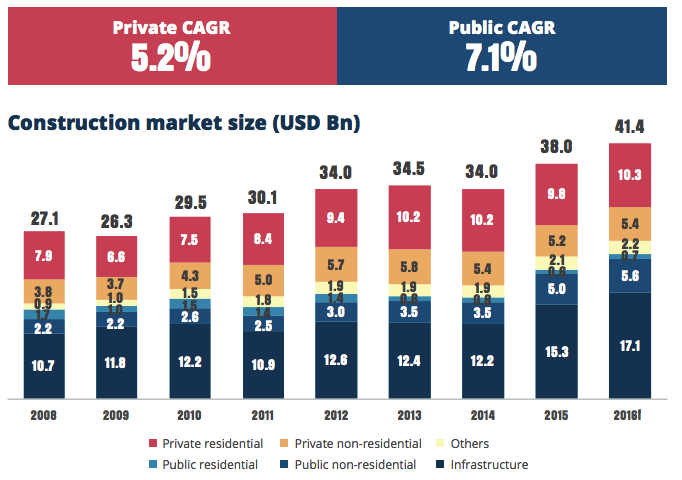

The construction market in Thailand is predicted to reach USD 41.4 billion in 2016. Around USD 17.9 billion of the market value is coming from the private sector while other USD 23.4 billion from the public sector.
In 2014-2015, due to the economic slowdown in Thailand, private construction market slightly decreased (CAGR -2%) from both residential and non-residential which are the main activities of private construction.
The economic slowdown led to both a lower demand for new residential buildings and a higher private debt, which discouraged the banks to provide loans. In 2015, the government focused on investment in Thailand’s transportation which led to a substantial increase in infrastructure investment.
The overall number of buildings rose between 2012 and 2014 with an average increase of 1.4% per year. However, the overall area built decreased by an average of 2.2% per year mainly due to a reduction of the average size of condominiums and industrial buildings in the country.
The commercial sector has seen growth in demand for commercial buildings (row house, restaurants etc.), office buildings and hotels, with a CAGR of 6.5% between 2012 and 2014, notably due to a surge of Small-to-Medium Enterprises (SMEs) in Thailand.
Meanwhile, the industrial construction sector continued to grow with a CAGR of 13.0% between 2012-2014, mainly driven by the expansion of automotive plants in an effort to attract foreign players across the supply chain. Main constructions concern factories, sewerage, power houses, power stations, solar energy installations, water supply infrastructure and filter plants. During the same period, new investments in industrial buildings in Thailand were largely made to restructure or revamp the facilities into smaller areas so as to optimize space usage.
Although Bangkok still holds the most market share, increasing urbanization in tier 2 cities should impact the construction landscape in the long run.
Bangkok’s city center is gradually expanding, following major infrastructure developments such as the prolongation of public transportation lines to vicinities outside of the capital. The areas which concentrate the most factories tend to become residential and commercial hubs.
In the East, construction activities are mainly driven by the industrial estates that have attracted industries wanting to benefit from the Board of Investments’ (BOI) support.

Exploring the Digital Health Competitive Landscape in Thailand
Thailand has experienced significant growth in its digital health market, propelled by the government's push towards digital transformation and the rising adoption of health technologies. The market encompasses a range of digital health solutions, including telemedicine, electronic health records (EHR), mobile health apps (mHealth), and wearable technologies. These conditions create a digital health competitive landscape in Thailand.

Global Changes in Technology Roles in Companies
The global changes in technology roles are reshaping business operations and strategies. We explore these changes in this article.

Exploring Thailand's Electric Vehicle Ecosystem: Growth, Segments, and Market Players
Thailand's electric vehicle (EV) ecosystem is undergoing rapid development, marked by diverse segments experiencing substantial growth and dynamic market shifts. The positive performance of EV segments in Thailand is expected to shape the future of transportation in the country.

ASEAN EV Market: Expanding Production in Thailand
Electric vehicle (EV) adoption in Southeast Asia has gained momentum in recent years, albeit slower than in other regions like Europe and China. Indonesia boasts the largest nickel deposits globally, while Vietnam's abundant nickel reserves make it ideal for battery production. Thailand, the region's largest producer and market for EVs, offers incentives to position itself as a base for EV manufacturing. These factors provide good provisions for the ASEAN EV industry.